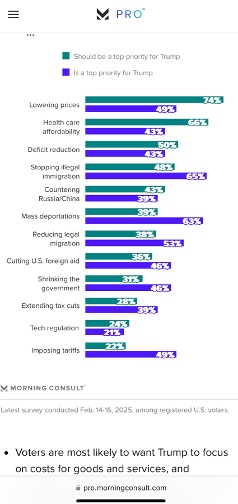February 2025
U.S. Political Update: What’s Going On in Washington
Region: US
Author: Karen A. Tramontano
Admittedly, it is a challenge to track all that is going on in Washington. No one, at this moment, with Republicans in control of the White House, Senate, and the House believes the pace of the President’s actions will slow down.
Admittedly, it is a challenge to track all that is going on in Washington. No one, at this moment, with Republicans in control of the White House, Senate, and the House believes the pace of the President’s actions will slow down.
We know you are reading both traditional and non-traditional press, so we think it may be best to highlight a few actions, their rationale and indicate the gaps between the voters and President Trump’s current agenda.
First, President Trump is “flooding the zone.” The strategy, which Trump employed in his first term, is based on overwhelming opponents and the press with a barrage of provocative policy initiatives making it impossible for the opposition to focus, leaving them disorientated and without a clear plan. It is working. The mainstream media is struggling to keep up with the whirlwind of activity and the Democrats are being criticized for not having a plan. With few procedural levers, the Democrats are finding it hard to set an offense.
Second, while the President’s approval rating is slightly above 50 percent, his net approval rating is only +7 points when looking at the President’s best polling numbers. Trump’s +7 honeymoon with voters lags way behind his predecessors. The net approval rating for President Biden at this time in his presidency was +21.8, for Obama + 46.9, and for George W Bush +27.9. Trump’s first term net approval was +3.2, so he is faring slightly better than his all-time low rating.
Third, there is a disconnect between what the voters voted for and what they are getting. Voters’ priorities continue to be focused on inflation (25%), jobs and the economy (12%), and healthcare (11%). No policy actions have been taken on these matters. The one area where the Trump Administration is acting is on immigration; immigration ranks about 9 percent in terms of priority issues with voters rounding out the top five issues.
To further demonstrate the disconnect between the Trump Administration’s priorities and voters’ priorities is a graph published by Morning Consult, a research firm that assesses public opinion on a variety of issues. In short, voters understand the Trump Administration’s priorities but, in many cases, they conflict with the change voters want to see.

Fourth, while voters believe corruption, inefficiency and “red tape” are major problems, many voters do not support Elon Musk’s actions against federal workers. For example, only 29 percent believe large numbers of federal jobs should be eliminated, while 40 percent are opposed. And only 23 percent believe entire federal agencies should be eliminated while 49 percent oppose.
Similarly, net support for dissolving the Department of Education is -28%, pardoning the January 6th rioters -25%, imposing tariffs on Canada and Mexico -16%. If President Trump continues to move on the path of destroying federal agencies that have an impact in the states, his net favorability may be short lived.
Finally, there are numerous lawsuits pending in the federal courts with several judges halting President Trump’s most controversial executive orders such as ending the U.S. Constitutional provision for birthright citizenship. Other lawsuits will make their way through the federal court system, and some may be heard by the U.S. Supreme Court. It may take months for the U.S. to understand the extent of the power of the presidency—a concept historically understood as quite limited.
